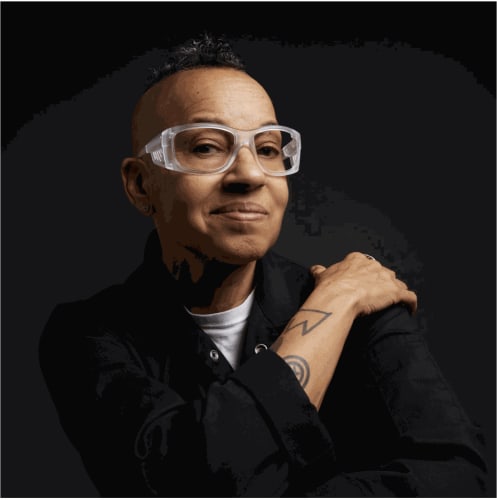This article is part of Hyperallergic’s 2024 Pride Month series, featuring interviews with art-world queer and trans elders throughout June.
In 1989, photographer Lola Flash sat on the other side of the lens for what would become one of the decade’s most iconic images. Flash, who uses she/they pronouns, kisses fellow artist Julie Tolentino in a poster of three queer couples and the phrase “Kissing Doesn’t Kill: Greed and Indifference Do,” a campaign launched by AIDS artist-activist collective Gran Fury. The image was distributed in a mass-mailing and plastered on buses and billboards.
Flash was already deeply involved in the AIDS activism movement through her work with ACT UP, and while the photographer has served as a pillar in their community since the 1980’s, they’ve only gained acceptance into the museum and gallery world in recent years. This was intentional, they told Hyperallergic over the phone. Below is a condensed version of a conversation that delved into the parental joy of becoming a mentor, finding love, and donning a space helmet to think about ancestors.
Hyperallergic: Can you speak about your entrance into the New York City art world? Did you feel accepted there, and how has your feeling of acceptance changed throughout the decades?
Lola Flash: I got to the city in the mid-’80s. I met a mural artist named Arnie Charnick, who did a lot of murals in the East Village. I had gone to art school and thought museums and galleries were the way to go, but Arnie was really against that. Since he had murals all over, he thought he didn’t need to be in galleries, and it was before graffiti or similar public art was shown in museums.
I wanted to be like him, so I didn’t want to show my work in museums. I felt that museums were about white walls, White people on the walls, and White audiences. It wasn’t appealing to me and it didn’t seem like a place I belonged. So for years, I didn’t want acceptance from the art world. I wanted the opposite, to be honest. In some ways, I wanted to be like one of those artists who dies and their artwork is found under the bed. It wasn’t about notoriety or fame or me: it was about creating an archive of my dear community.
It wasn’t until I turned 60 that I decided I wanted to make it happen for myself in the art world. I had seen a Kerry James Marshall show at The Met, and it changed my thoughts on showing my work. The audience was still mostly White, but there were some Black people there, too. Those spaces have gotten better. People were really looking at the work, and one girl was crying.
It made me think, “Maybe the world is ready to see my work.” I reached out to MoMA and said, “You need to give me a studio visit”. That was the beginning of my life now. Once MoMA buys your work, the Whitney wants to buy it, too. It hasn’t been a landfall, but there’s definitely been a change in the way people greet me and accept me.


